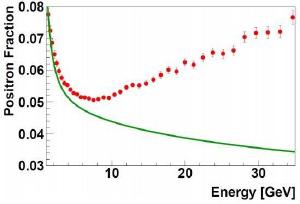Blog
Counting in the Dark
20 September 2014
 NASA
NASAThe Alpha Magnetic Spectrometer (AMS) is a particle detector located on the International Space Station. It’s designed to detect high energy particles known as cosmic rays, and a while back it made news regarding claims it had detected dark matter. It hadn’t, but instead had detected an excess of positrons that might be due to dark matter. It could also be due to other things, which is why claiming it had found evidence of dark matter was a bit disingenuous. Now the AMS is back with more data. Despite some claims, the new results don’t hint at dark matter any more than last time, but it is still solid work.
Cosmic rays are very high energy particles (typically protons) produced by various astrophysical phenomena. They were first detected by their effect when striking Earth’s atmosphere, which causes a cascade of particles to be produced. Most cosmic ray astronomy is done on Earth by looking at these particle cascades. While this gives us a good idea of the types of energies cosmic rays can have, it doesn’t tell us much about the types of particles that make up cosmic rays. We’ve known for a while that they are mostly protons, but they can also be electrons and positrons, among other things. positroncount
 M. Aguilar et al
M. Aguilar et alBecause the AMS is on the space station, it can detect these cosmic rays directly, so it can distinguish between protons, electrons, positrons and the like. By looking at the ratio of protons to electrons, and positrons to electrons, we can start to understand the types of mechanisms that produces cosmic rays. Since the last media debacle, the AMS has continued to gather more observations, and this new work provides an update of the latest results.
These new results basically just refine the earlier findings.1 Like last time, the ratio of positrons to electrons within cosmic rays increases at higher energies. This is interesting because standard collisions of high energy particles with interstellar matter should produce a decrease of positrons at higher energies. This suggests that there are other mechanisms going on.
One of these mechanisms is theoretically dark matter, but this new result should not be taken as evidence of dark matter. Black holes, pulsars, white dwarfs, etc. could all account for a similar increasing ratio. The big result here is not that it’s evidence of dark matter, but simply the fact that we have an accurate particle count. We’ve actually suspected that the fraction of positrons would increase at higher energies, and now we actually have the evidence to back up that suspicion.
The next step will be to see what details from these cosmic ray counts we can gather, so we can use the results to narrow down possible sources. There are a lot of very high energy interactions happening in deep space, and cosmic ray particle counts should help us better understand them.
Aguilar, M., et al. “Electron and positron fluxes in primary cosmic rays measured with the Alpha Magnetic Spectrometer on the International Space Station.” Physical Review Letters 113.12 (2014): 121102. ↩︎